NIST Smart Connected Systems Newsletter
December 2022
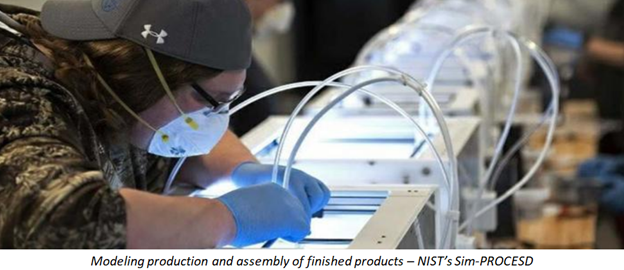 Earlier in 2022, NIST researchers released a simulation package that models the behavior of "discrete manufacturing systems," which include the production and assembly of finished products, like vehicles, consumer electronics, and consumer goods. The package is called "Simulated-Production Resource for Operations and Conditions Evaluation to Support Decision-Making," or Sim-PROCESD, and the software is publicly available.
The simulation focuses on asynchronous production lines, which move jobs to workstations when they are available, rather than moving jobs simultaneous in a line. The simulation also can model the degradation and maintenance of machines involved.
Users can configure the simulation to model various real-world manufacturing systems. Sim-PROCESD also allows users to change the behaviors of existing systems to model more complex processes. Additionally, Sim-PROCESD aids simulation-based optimization and planning applications – such as for evaluating alternative maintenance policies for a particular system. And users can model expected system performances under various policies, with Sim-PROCESD supporting simulation replication.
There is interest in Sim-PROCESD from various stakeholders, including university and government organizations. NIST researchers are presenting on the use of Sim-PROCESD in the course, "Modeling and Control of Manufacturing Processes," conducted by the University of Virginia's Department of Mechanical and Aerospace Engineering. NIST researchers also are in discussion with other government agencies in exploring ways this software can streamline planning for new facilities and operations.
Back to Top
 In November 2022, NIST's Allison Barnard Feeney, Group Leader of Smart Connected Manufacturing Systems, contributed to ISO 10303 working group's development of a standard for industrial data, termed, "Standard for the Exchange of Product Data." The working group met in Japan, in its first in-person meeting in three years.
This development includes a standard information protocol for manufacturing and product data that can be read by a variety systems involved in the lifecycle of goods, such as the different systems which design, manufacture, and assemble products. Each system will get the product information needed for their respective functions. As examples, data for computer-assisted design will be in the form of geometry and topology, while manufacturing data will have geometric dimensions and tolerances.
In other words, all involved in the product life cycle, will operate off the "same sheet of music," while each get and use their unique data – which was not the case previously. This standardization of industrial data will make production faster and more efficient.
This data standardization is termed, "Managed Model-based 3D Engineering." Its specifics will be addressed in "Application Protocol 242 (AP242),” which means it will be implemented in software. The software will give users new capabilities to include persistent identification of data, harmonization of standards related to industrial data, and harmonized modeling. Barnard Feeney is providing technical leadership in the development of AP242, which includes facilitating research to inform development.
Back to Top
 NIST's Smart Connected Systems Division Chief, Abdella Battou, recently addressed the Advanced Communications Technology Working group (ACTWG). The Advanced Communications Technologies Working Group of the Interagency Committee on Standards Policy (ICSP) provides an overview of Federal agency advanced communications technologies (ACT) standards activities and recommends standards priority areas for ICSP consideration. The ACTWG comprises key representatives from 18 U.S. Federal agencies with interests in the technical foundations for standards in communications technologies.
Battou stated that quality of service is a fundamental infrastructure technology, which manages competing demands for network resources while maximizing user experiences. This technology addresses the following traffic issues:
- Delay/Latency: Time it takes for data packets to reach their destinations
- Jitter: Delay variations in the sequential delivery of data packets
- Packets Dropped: How many data packets are delivered, of those sent
Battou also described the tools enabling quality of service:
- Analyzing data packets in a flow and specifying treatment of the flow
- Allocating network resources for traffic flow and avoiding congestion
- Queuing traffic flow when network resources are exceeded
Additionally, Battou covered quality of service levels, ranging from no service restoration, to protected paths with auto-restoration if they fail.
Future quality of service will be a challenge as communications go beyond one-size-fits-all connectivity and support increasingly differentiated services. Challenges include 5G wireless network access and an estimated 90 percent of network traffic being video.
Battou posed the question, can quality of service be achieved for time-sensitive applications, such as smart grid, automated vehicles, and industrial control? He then offered the following possibilities:
- Time-sensitive Networking: Bounds latency for delivery. IEEE is developing TSN standards.
- Deterministic Networking: Applies time-sensitive networking to routers for routing data streams.
- Optical Transport Networking: Has a constant data rate, with almost no jitter and fixed latency.
Back to Top
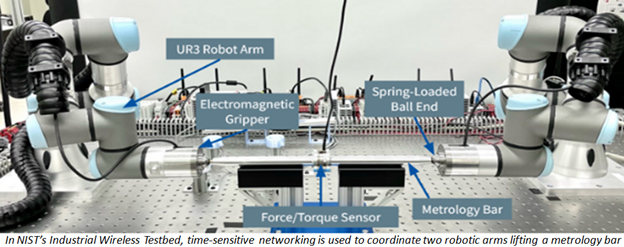 In a presentation at the Workshop on Industrial Wireless Technologies and Systems, held at the October IECON 2022 Conference in Brussels, Belgium, NIST's Rick Candell provided an overview of NIST's research on time-sensitive networking for industrial wireless applications.
Candell emphasized that time-sensitive networking (TSN) has emerged as a suitable candidate for improving reliability and meeting the latency requirements of certain time-critical industrial applications. Generally, wireless systems promise advantages to industry. Compared to present wired systems, wireless systems are envisioned as being cheaper to install, simplifying infrastructure, facilitating reconfiguration, and enabling greater automated control. But their deployment also faces challenges such as range limits, interference, attenuation, and more.
NIST is advancing the adoption of industrial wireless systems through experimentation, demonstrations, and research collaboration with industry, stated Candell. As examples, NIST has published:
NIST's work is also informing the IEEE P1451.5p Working Group, which is developing a standard to support the assessment of industrial wireless systems and their performance.
NIST research is focusing on time-sensitive networking, as it has a good possibility of ensuring quality of service, said Candell. This networking was created for audio/video applications, which require timely data delivery for users. It allows for the partitioning of the wireless channel into windows for particular applications, thus greatly improving on-time reliability. And some IEEE standards address time synchronization and traffic scheduling. NIST has conducted experiments with time-sensitive networking in its Industrial Wireless Testbed, including coordinating two industrial robotic arms, also described in the following article.
Back to Top
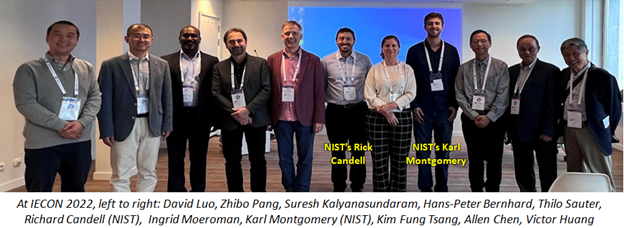 At the IECON 2022 Conference in Brussels, Belgium, October 2022, NIST's Industrial Wireless Systems researchers reported on their demonstration of wireless, time-sensitive networking to coordinate two industrial robotic arms lifting a heavy object. NIST's Karl Montgomery delivered the presentation, based on the paper, Operational Impacts of IEEE 802.1Qbv Scheduling on a Collaborative Robotic Scenario, authored by NIST's Rick Candell, Karl Montgomery, Mohamed Hany, and Intel Labs' Dave Cavalcanti.
Industrial wireless promises flexibility, reconfiguration, and mobility for industrial systems. These attributes also depend on timely communication between systems and their synchronization, which are possible with time-sensitive networking, as specified in the IEEE 802.1Qbv standard.
NIST and Intel Labs researchers sought to demonstrate this potential and set up a time-sensitive network in the NIST's Industrial Wireless Testbed to perform experiments. This effort included implementing a customized, time-aware, IEEE 802.1Qbv schedule and global, time synchronization of devices and data collectors to enable wireless time sensitive network features.
The wireless time-sensitive network enabled the coordinated movement of two robotic arms, controlled by a customized software program developed by the NIST team. The robotic arms, with customized grippers, jointly lifted a metrology bar with an integrated force-torque sensor and moved the bar in several coordinated directions. This represents collaborative robots, or cobots, to maximize efficiency and safety in automated manufacturing. Cobots are designed to work alongside humans with no safety fencing required.
Researchers demonstrated that wireless time-sensitive networking can:
- Reduce latency
- Improve network reliability
- Improve physical performance in industrial use cases, in which wireless is the primary communications method
- Improve performance in an application with a one-way latency requirement of 8 milliseconds or less
- Provide advantages for many applications with bounded latency requirements
Future work will include upgrading the testbed with an infrared vision tracking system to reduce error uncertainties between the robot positions; implementing a more efficient schedule to better accommodate the transmission traffic stream; and transitioning to the IEEE 802.11ax standard for Wi-Fi 6.
Back to Top
 Wireless systems promise big changes in industry, including cost savings. It is estimated that industrial wireless will provide 20 percent to 30 percent savings over wired systems' installation. But deployment of industrial wireless systems faces certain challenges, such as interference and range limitations. Moreover, no existing standard yet addresses industrial wireless testing needs.
That is about to change, said NIST's Rick Candell at the recent ISA Automation and Leadership Conference held in Galveston, Texas. Candell presented a talk addressing the forthcoming IEEE P1451.5p, "Standard for Radio Frequency Channel Specifications for Performance Assessment of Industrial Wireless Systems."
Candell, who also chairs the IEEE P1451.5p Working Group, said the proposed standard's objective is to define a process for evaluating industrial wireless communications systems' performance. Specifically, the standard will establish:
- A process for identifying and evaluating aggressors, such as interference and attenuation
- A radio frequency reference model with definitions and specifications
- Recommendations for setting up and conducting tests
- Profiles for different industrial scenarios and applications
The IEEE P1451.5p Working Group is developing the proposed standard, based on field data, models, and experiments. Once developed by the working group and approved by the IEEE-SA Standards Board, the standard will apply to all wireless protocols in industrial and mission critical settings, said Candell.
Back to Top
 In October 2022, international collaborators, including NIST researchers, met in Jeju, South Korea, to define a path to federated 5G Testbeds, dubbed "Project Agility," launched by the Korea Institute for Advancement of Technology. The same international collaborators had met at NIST in Gaithersburg, Maryland in May 2022, to discuss technical details, division of labor, and scheduling for the project.
The goal of Project Agility is to develop testbeds that use 5G to access federated cloud computing, which ties together computing clouds in multiple sectors – government, industry, etc. Compared to today, 5G will give developers faster and greater access to data from more sources. Just as 4G enabled streaming, federated 5G is expected to lead to new innovations. Also, these linked testbeds will allow a testbed to remotely use technologies at other testbeds, enabling even more innovations.
At the October meeting, Project Agility members developed the following objectives leading to federated 5G testbeds:
- Develop an architectural framework for federated 5G testbeds to do cross-industry innovation
- Specify the framework's interconnection requirements for federated 5G testbeds
- Define and demonstrate a use case for federated 5G testbeds to do cross-sector innovation
- Implement programming interfaces for federated 5G testbeds
- Demonstrate management and control for federated 5G testbeds to execute the use case.
At the meeting, the NIST lead on Project Agility, Robert Bohn, presented on how IEEE 2302-2021 Standard for Intercloud Interoperability and Federation could help achieve federated cloud computing. Project Agility will use the majority of this standard to develop its architecture.
Project Agility presented its federated 5G tested plan at the International Conference on Information and Communication Technology 2022, also conducted in Jeju, South Korea, and which held a session on Project Agility, titled Network/Service Federation for 5G and Beyond.
Back to Top
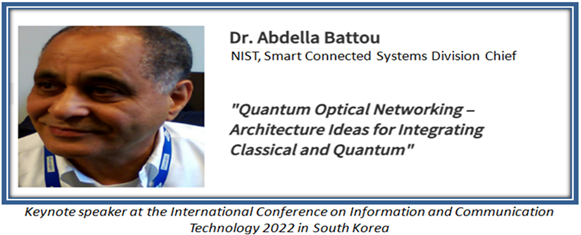 NISTs Smart Connected Systems Division Chief, Abdella Battou, gave a videoed keynote address on integrating classical and quantum communications in the Internet, at the International Conference on Information and Communication Technology 2022, in Jeju, South Korea.
In the internet, pulses of light transmit messages. The Internet's classical communications use light bursts to convey messages in bits. By comparison, quantum-enabled, optical communications channels use much smaller light bursts, conveying messages in qubits. Relative to classical channels, quantum has shown greater message accuracy and quantum's unique properties can enable encrypted messages. Thus interest in developing quantum communication channels has increased significantly.
Battou addressed how increased quantum channels could be integrated into the Internet. He noted that quantum channels must use existing Internet infrastructure – rather than build new infrastructure – and work with classical communications, complementing each other's strengths.
Battou proposed three layers of integration:
- Lowest and easiest level would be building "optical cross connects" into networks, allowing connection of quantum devices at the edge
- Enabling an architecture with wavelength integration in management and control planes software
- Enabling an architecture with optical label switching for packet integration
Battou also noted the challenges facing integration of classical and quantum communications integration in the Internet. Researchers must assess how well classical and quantum signals can coexist. They also must determine this integration's scalability – how many users and activities can it accommodate. Additionally, classical and quantum signals must be synchronized in the architecture.
Back to Top
 "Interoperability is foundational to the development of more inclusive grid institutions." That was the key point made by NIST's Cheyney O’Fallon and Avi Gopstein in their article, Reducing Barriers to Entry and Hedging Against Obsolescence With Smart Grid Interoperability in Competition Policy International, November 2022. As the article's title indicates, increased smart grid interoperability can dissolve barriers to entry for new participants, contribute to creating value for the electric grid, and prevent obsolescence from eroding gains as technologies rapidly evolve.
The authors give multiple examples of how increased interoperability is needed to transform the grid. They note that lack of interoperability is the last barrier to full use of renewables, like wind and solar, in electricity markets and operations. Also, increased interoperability is needed to help prevent market fragmentation which divides critical network infrastructure.
Their most illustrative example of interoperability's potential is the water heater. It is designed to have a long lifetime, during which more cost-efficient replacements will emerge. Part of the problem of swapping out water heaters lies in removing a heavy system from existing plumbing. Consequently, less efficient heaters remain in service longer and possible energy savings go unrealized. The authors also note that if a multitude of water heaters could communicate demand to the grid, system operators could better manage grid loads and reduce generation costs – with no inconvenience to customers.
Moreover, the need for increased interoperability is growing. Energy executives and households face rising costs, while a complex global economy is trying to reconfigure itself to deal with threats to public health, cybersecurity, resource production, and energy delivery. Greater grid interoperability can give decision makers more options when dealing with events, ranging from economic shocks to low-probability, high-impact events that can overcome even the best plans.
Back to Top
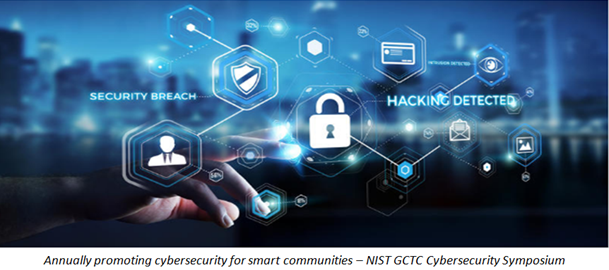 NIST's Global City Teams Challenge (GCTC) conducted its annual Cybersecurity Symposium for Smart Cities, in late October 2022. The following are a few of the key highlights.
Enhancing Regional Cybersecurity: Mikyung Kim-Molina with the California Bay Area Urban Areas Security Initiative addressed the following initiatives:
Regional cyber governance structure, termed "Cyber Navigator:" This initiative allows all Bay Area's chief information officers to share cybersecurity and threat information. This governance structure is also pursuing a multiyear strategy plan and cyber incidence response and recovery plans, in accordance with the NIST Cybersecurity Framework.
Regional Center of Cybersecurity Excellence: This Center will support multiple jurisdictions, with systems, information-sharing and monitoring. It will also create policies and protocols for regional incidence response and technology solutions. Additionally, the Center will conduct exercises to test regional cybersecurity capabilities.
Ensuring Digital Privacy and Civil Liberties in Smart City Projects: Albert Gehami, Digital Privacy Officer in City of San Jose, CA, and Lee McKnight, professor at Syracuse University, provided the following insights:
- When privacy laws do not exist in a community, NIST's Privacy Framework provides a high-level approach and a good start. It calls for identifying data, governing it, controlling it, communicating with people, and protecting data.
- When considering use of surveillance systems, smart city project leaders should actively engage with community members, who can provide input on where cameras are needed most for security.
Back to Top
 In its recent quarterly issue, the Spanish journal, Equipamiento y Servicios Municipales (Equipment and Municipal Services), published its interview with NIST's Michael Dunaway, titled "More Data to Prove That Using Big Data Is Profitable" (page 89). The interview addressed the value of smart cities investing in big data projects. The following is a translated except from the article.
'Several studies have recently been completed that attempt to determine the potential cost savings or return on investment for cities in adopting smart technologies. For example, a 2019 study by ESI ThoughtLab collected information data from 100 cities and demonstrated a positive ROI,' specifies Michael Dunaway. (English translation of caption in above graphic)
"This study showed that 38 % of the cities that implement smart mobility solutions increase their citizen satisfaction; 32 % improve productivity and delivery times for companies; the 45 % of cities that implement smart environmental and energy initiatives improve the health of citizens; 44 % reduce pollution; and 43 % stabilize energy prices.
Michael Dunaway, Martin Serrano, and other researchers of the NIST have published a guide so that the cities identify the key indicators of the benefits of adopting smart city systems. In the report Smart Cities and Communities: A Key Performance Indicators Framework, they developed a methodology to measure how smart a city is. Among the metrics are 'alignment of investments with community priorities, the efficiency of investments, the quality of infrastructure services, and the benefits to the community,' explains Dunaway.
One way to improve the urban strategy and measurement is with data; the data itself brings benefits to cities."
Back to Top
 Industries may use "condition monitoring systems" (CMS) to monitor machines and enterprises – like production lines – for detrimental or unexpected changes in order to mitigate any faults, failures, and other costly scenarios. However, users are often hesitant to adopt these systems because it is unclear what their return on investment would be. A CMS’s value is derived from preventing unwanted events and calculating costs of those prevented events is difficult. Condition monitoring systems that use artificial intelligence are even harder to evaluate, because when intellectual property concerns prevent disclosure of their internal logic, operators fear they may behave in unexpected ways.
To help evaluate condition monitoring systems for their ability to prevent risks, NIST researchers published Key Elements to Contextualize AI-Driven Condition Monitoring Systems towards Their Risk-Based Evaluation. The paper was recently presented at the 2022 5th IEEE International Artificial Intelligence for Industries Conference.
The paper helps potential users determine the differences in risks with and without condition monitoring systems. The differences help indicate benefit to the industrial system directly from adding the risk-mitigating capabilities of the CMS. To this end, the paper provides:
- Context for the CMS's objective of reducing risk
- Insight into how the CMS is configured in design and operation
- The importance of these elements in evaluating a CMS
The paper then breaks down the key elements that help determine how the condition monitoring system is designed and operated, and which can be used in its evaluation:
- Area of application: Determines the physical systems covered by the CMS, as well as limitations and requirements
- Monitoring mechanisms: Sources of information, such as sensors, inspection reports, and other observations about the area of application that can be used by the CMS to inform risk management of hazardous scenarios
- Risk management processes: Processes, tools, and policies that detect, process, act on hazards and interact with the area of application covered by the CMS
The paper shows how these key elements can be used to construct an evaluation process that captures the impact of condition monitoring systems.
Back to Top
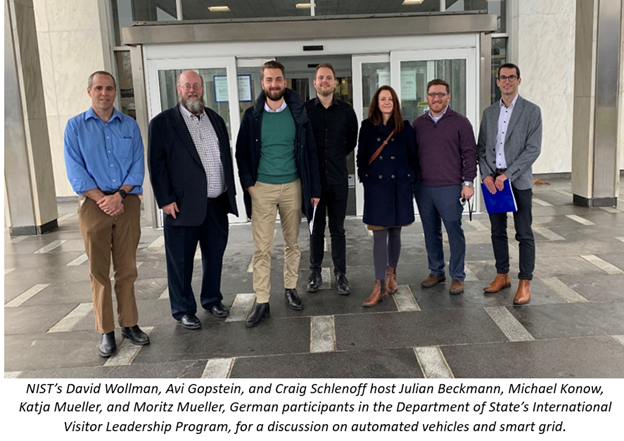 On December 7, 2022, NIST Communications Technology Laboratory’s David Wollman and Avi Gopstein, together with NIST Engineering Laboratory’s Craig Schlenoff, hosted a visit by German participants in the U.S. Department of State’s International Visitor Leadership Program to NIST in Gaithersburg, MD. This interaction explored innovation in U.S. and German energy and transportation sectors. The group had a wide-ranging, engaging discussion on multiple topics in this space, including international standardization, infrastructure, communication protocols, frameworks, and interactions with industry and government stakeholders.
Avi Gopstein presented on the latest developments in smart grid, including the NIST Framework and Roadmap for Smart Grid Interoperability Standards, Release 4.0 and the subsequent development of interoperability profiles. David Wollman and Craig Schlenoff presented on smart connected infrastructures, smart cities and communities, automated driving safety measurement, and the NIST-wide collaborative automated vehicle program, including automated vehicle communications, sensing and perception, artificial intelligence, cybersecurity, and system interaction.
According to the U.S. Department of State, the International Visitor Leadership Program (IVLP) is its premier professional exchange program. The IVLP program participants were Julian Beckmann, Michael Konow, Katja Mueller, and Moritz Mueller, who are influential business and public sector leaders from different regions of Germany.
Back to Top
|